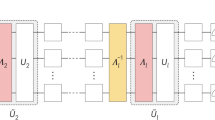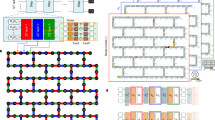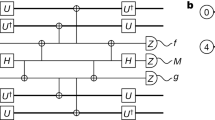Abstract
Noise is the central obstacle to building large-scale quantum computers. Quantum systems with sufficiently uncorrelated and weak noise could be used to solve computational problems that are intractable with current digital computers. There has been substantial progress towards engineering such systems1,2,3,4,5,6,7,8. However, continued progress depends on the ability to characterize quantum noise reliably and efficiently with high precision9. Here, we describe such a protocol and report its experimental implementation on a 14-qubit superconducting quantum architecture. The method returns an estimate of the effective noise and can detect correlations within arbitrary sets of qubits. We show how to construct a quantum noise correlation matrix allowing the easy visualization of correlations between all pairs of qubits, enabling the discovery of long-range two-qubit correlations in the 14-qubit device that had not previously been detected. Our results are the first implementation of a provably rigorous and comprehensive diagnostic protocol capable of being run on state-of-the-art devices and beyond. These results pave the way for noise metrology in next-generation quantum devices, calibration in the presence of crosstalk, bespoke quantum error-correcting codes10 and customized fault-tolerance protocols11 that can greatly reduce the overhead in a quantum computation.
This is a preview of subscription content, access via your institution
Access options
Access Nature and 54 other Nature Portfolio journals
Get Nature+, our best-value online-access subscription
$29.99 / 30 days
cancel any time
Subscribe to this journal
Receive 12 print issues and online access
$209.00 per year
only $17.42 per issue
Buy this article
- Purchase on Springer Link
- Instant access to full article PDF
Prices may be subject to local taxes which are calculated during checkout




Similar content being viewed by others
Data availability
Source data are available for this paper at https://github.com/rharper2/EfficientLearningDataSet. All other data that support the plots within this paper and other findings of this study are available from the corresponding author upon reasonable request.
Code availability
Details of code that was used to analyse the data is available from the corresponding author upon reasonable request.
References
Schindler, P. et al. Experimental repetitive quantum error correction. Science 332, 1059–1061 (2011).
Reed, M. D. et al. Realization of three-qubit quantum error correction with superconducting circuits. Nature 482, 382–385 (2012).
Barends, R. et al. Superconducting quantum circuits at the surface code threshold for fault tolerance. Nature 508, 500–503 (2014).
Nigg, D. et al. Quantum computations on a topologically encoded qubit. Science 345, 302–305 (2014).
Kelly, J. et al. State preservation by repetitive error detection in a superconducting quantum circuit. Nature 519, 66–69 (2015).
Córcoles, A. D. et al. Demonstration of a quantum error detection code using a square lattice of four superconducting qubits. Nat. Commun. 6, 6979 (2015).
Ofek, N. et al. Extending the lifetime of a quantum bit with error correction in superconducting circuits. Nature 536, 441–445 (2016).
Linke, N. M. et al. Fault-tolerant quantum error detection. Sci. Adv. 3, e1701074 (2017).
Martinis, J. M. Qubit metrology for building a fault-tolerant quantum computer. npj Quantum Inf. 1, 15005 (2015).
Tuckett, D. K., Bartlett, S. D. & Flammia, S. T. Ultrahigh error threshold for surface codes with biased noise. Phys. Rev. Lett. 120, 050505 (2018).
Aliferis, P. & Preskill, J. Fault-tolerant quantum computation against biased noise. Phys. Rev. A 78, 052331 (2008).
Neill, C. et al. A blueprint for demonstrating quantum supremacy with superconducting qubits. Science 360, 195–199 (2018).
Chuang, I. L. & Nielsen, M. A. Prescription for experimental determination of the dynamics of a quantum black box. J. Mod. Opt. 44, 2455–2467 (1997).
Blume-Kohout, R. et al. Demonstration of qubit operations below a rigorous fault tolerance threshold with gate set tomography. Nat. Commun. 8, 14485 (2016).
Kimmel, S., da Silva, M. P., Ryan, C. A., Johnson, B. R. & Ohki, T. Robust extraction of tomographic information via randomized benchmarking. Phys. Rev. X 4, 011050 (2014).
Gross, D., Liu, Y.-K., Flammia, S. T., Becker, S. & Eisert, J. Quantum state tomography via compressed sensing. Phys. Rev. Lett. 105, 150401 (2010).
Flammia, S. T., Gross, D., Liu, Y.-K. & Eisert, J. Quantum tomography via compressed sensing: error bounds, sample complexity, and efficient estimators. New J. Phys. 14, 095022 (2012).
Riofrío, C. A. et al. Experimental quantum compressed sensing for a seven-qubit system. Nat. Commun. 8, 15305 (2017).
Emerson, J., Alicki, R. & Życzkowski, K. Scalable noise estimation with random unitary operators. J. Opt. B 7, S347 (2005).
Knill, E. et al. Randomized benchmarking of quantum gates. Phys. Rev. A 77, 012307 (2008).
França, D. S. & Hashagen, A. K. Approximate randomized benchmarking for finite groups. J. Phys. A 51, 395302 (2018).
Proctor, T. J. et al. Direct randomized benchmarking for multiqubit devices. Phys. Rev. Lett. 123, 030503 (2019).
Wallman, J., Granade, C., Harper, R. & Flammia, S. T. Estimating the coherence of noise. New J. Phys. 17, 113020 (2015).
Helsen, J., Xue, X., Vandersypen, L. M. K. & Wehner, S. A new class of efficient randomized benchmarking protocols. npj Quantum Inf. 5, 71 (2019).
Erhard, A. et al. Characterizing large-scale quantum computers via cycle benchmarking. Nat. Commun. 10, 5347 (2019).
Emerson, J. et al. Symmetrized characterization of noisy quantum processes. Science 317, 1893–1896 (2007).
Gambetta, J. M. et al. Characterization of addressability by simultaneous randomized benchmarking. Phys. Rev. Lett. 109, 240504 (2012).
Flammia, S. T. & Wallman, J. J. Efficient estimation of Pauli channels. Preprint at https://arxiv.org/abs/1907.12976 (2019).
Knill, E. Quantum computing with realistically noisy devices. Nature 434, 39–44 (2005).
Wallman, J. J. & Emerson, J. Noise tailoring for scalable quantum computation via randomized compiling. Phys. Rev. A 94, 052325 (2016).
Ware, M. et al. Experimental demonstration of Pauli-frame randomization on a superconducting qubit. Preprint at https://arxiv.org/abs/1803.01818 (2018).
Wright, K. et al. Benchmarking an 11-qubit quantum computer. Nat. Commun. 10, 5464 (2019).
Chubb, C. T. & Flammia, S. T. Statistical mechanical models for quantum codes with correlated noise. Preprint at https://arxiv.org/abs/1809.10704 (2018).
Koller, D. & Friedman, N. Probabilistic Graphical Models: Principles and Techniques (MIT Press, 2009).
Aleksandrowicz, G. et al. Qiskit: an open-source framework for quantum computing. Zenodo https://doi.org/10.5281/zenodo.2562110 (2019).
Harper, R. & Flammia, S. T. Fault-tolerant logical gates in the IBM quantum experience. Phys. Rev. Lett. 122, 080504 (2019).
Harper, R., Hincks, I., Ferrie, C., Flammia, S. T. & Wallman, J. J. Statistical analysis of randomized benchmarking. Phys. Rev. A 99, 052350 (2019).
Acknowledgements
We thank S. Bartlett, A. Doherty, J. Emerson and T. Monz for comments on an earlier draft. This work was supported in part by US Army Research Office grant nos. W911NF-14-1-0098 and W911NF-14-1-0103, the Australian Research Council Centre of Excellence for Engineered Quantum Systems (EQUS) CE170100009, the Government of Ontario, and the Government of Canada through the Canada First Research Excellence Fund (CFREF) and Transformative Quantum Technologies (TQT), Natural Sciences and Engineering Research Council (NSERC), Industry Canada.
Author information
Authors and Affiliations
Contributions
R.H., S.T.F. and J.J.W. conceived the experiments, and S.T.F. and J.J.W. conceived the original methodology. The implementation was carried out by R.H. R.H. wrote the initial draft and all authors contributed to the revisions and editing of the manuscript.
Corresponding author
Ethics declarations
Competing interests
J.J.W. is the chief technology officer of the company Quantum Benchmark, Inc., and S.T.F. and R.H. were both consultants for it for part of the duration of this project.
Additional information
Peer review information Nature Physics thanks Jonas Bylander, Diego Risté, Marcus da Silva and the other, anonymous, reviewer(s) for their contribution to the peer review of this work.
Publisher’s note Springer Nature remains neutral with regard to jurisdictional claims in published maps and institutional affiliations.
Supplementary information
Supplementary Information
Supplementary Figs. 1–6, discussion and Tables 1–7.
Source data
Source Data Fig. 2
Correlation matrix data, high and low error bounds.
Source Data Fig. 3
Correlation matrix data, high and low error bounds.
Source Data Fig. 4
Data used for Fig. 4 plot.
Rights and permissions
About this article
Cite this article
Harper, R., Flammia, S.T. & Wallman, J.J. Efficient learning of quantum noise. Nat. Phys. 16, 1184–1188 (2020). https://doi.org/10.1038/s41567-020-0992-8
Received:
Accepted:
Published:
Issue Date:
DOI: https://doi.org/10.1038/s41567-020-0992-8
This article is cited by
-
Quantum circuit fidelity estimation using machine learning
Quantum Machine Intelligence (2024)
-
Quantum process tomography with unsupervised learning and tensor networks
Nature Communications (2023)
-
Benchmarking universal quantum gates via channel spectrum
Nature Communications (2023)
-
Efficient noise mitigation technique for quantum computing
Scientific Reports (2023)
-
Surpassing spectator qubits with photonic modes and continuous measurement for Heisenberg-limited noise mitigation
npj Quantum Information (2023)



